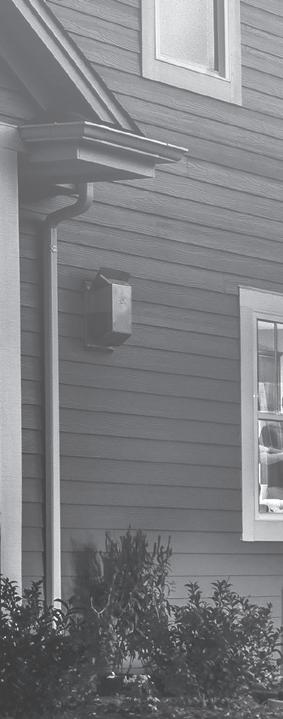STORM PREPAREDNESS Guide STORM PREPAREDNESS Guide

• Tornado safety guide
• How to handle driving in heavy rain
• 7 most common questions about automatic home generators

• How pet owners can prepare for disasters in advance
• And more!


• Tornado safety guide
• How to handle driving in heavy rain
• 7 most common questions about automatic home generators

• How pet owners can prepare for disasters in advance
• And more!
Roughly 1,000 tornadoes per year are reported to the National Oceanic and Atmospheric Administration. Tornadoes are intense, violent storms that feature a column of air that extends from a thunderstorm cloud to the ground.
Tornadoes can occur anywhere in the world. However, the United States experiences more tornadoes than any other country.

Tornadoes, although impressive to watch, are volatile storms with great power. They have the capability to flip cars, destroy buildings and send deadly debris flying into the air. Intense winds can reach more than 200 miles per hour.
The Department of Homeland Security notes that there are many things people can do to keep themselves safe from tornadoes before, during and after these storms.
Before Understand and learn about the risk for tornadoes where you live. People in the midwestern and southwestern United States have a greater risk of experiencing tornadoes than those elsewhere in the country.
Establish a safe room in your home, which can be a basement or a cellar. In rooms with no belowground levels, the safest place is a small, interior room on the lowest level away from windows and doors.
Sign up for emergency alert warning systems that cater to your area so you know well in advance if
a tornado is coming. Practice what to do in the event of a tornado so the entire family knows what to do if disaster strikes.
Keep tornado readiness supplies handy. These include clean water, batteries, flashlights, a battery-powered radio, and packaged, nonperishable foods.
During
Move indoors into a safe location for the duration of the tornado. Tornadoes blow through quite quickly so timing is of the essence. If you cannot get to shelter, lay down flat in a low-lying area. Do not go under a highway overpass or attempt to outrun a tornado in a vehicle.
Take additional precautions by shielding your head and neck with your arms or putting furniture and blankets around you to protect against debris.
Keep small children and pets close by and protect them as best as possible. Strapping an infant into a vehicle safety seat may be a good safety measure. After
Assess the situation for safety after the tornado has moved through. Watch for downed electrical lines and check for the smell of gas. Do not turn on any appliances or switches if you detect the aroma of gas.
Do not try to move anyone who seems seriously injured unless they are in immediate danger. Call and wait for help if needed. It may take time for emergency personnel to reach you.
More information is available at www.ready.gov/tornadoes.
Short-term power outages can be a minor inconvenience. A long-term power outage can cause a major disruption to daily life.
Weather is hard to predict. Meteorologists have many tools at their disposal to help forecast storms and other phenomena, but it is impossible to predict the weather with 100 percent accuracy.

When the weather takes a turn for the worse, the National Weather Service may issue certain notices to prepare the public. Understanding the level of threat a notice carries can help people take appropriate action and avoid serious consequences.
The NWS uses a four-tier system to alert the public of hazards. Here’s a closer look at what each tier constitutes.
This is the least serious weather alert. It usually means that hazardous weather may approach in the next three to seven days. The public should monitor the situation and stay tuned for further updates.
With an advisory, weather conditions are not overly serious but could prove inconvenient. Individu-
als should be cautious and prudent when preparing supplies or traveling.
During a weather watch, there is an increased risk of a hazardous weather occurrence, though the timing or location is still uncertain. This is when it is essential to practice an evacuation or preparedness plan and stock up on any last-minute supplies.
The most serious of the weather impact notifications, a warning constitutes an imminent or likely event. The weather may cause a threat to property or life. Immediate action to stay safe is necessary.
While these alerts are based on the severity of impending weather, it is important to note that the NWS will not necessarily follow the same timeline with issuing alerts. That depends on how fast a weather situation develops. If there is time, an advisory, then a watch and then a warning may be issued. However, if a storm moves in rapidly, only a warning may be issued. People always should pay attention to weather notices so they can be prepared should severe weather be in the forecast.
The U.S. Energy Information Administration’s Annual Electric Power Industry Report says interruptions in electric service vary by frequency and duration across the many electric distribution systems that serve the country. In the most recent year for data, customers experienced an average of 1.3 interruptions and went without power for around four hours.
When a storm strikes or an accident knocks out electric power lines or other infrastructure, it may take much longer for power to be restored. During Superstorm Sandy in 2012, more than eight million people lost power and outages lasted for days in some major cities. Outlying areas were without power for weeks, according to National Geographic. It’s important to know how to handle a power outage to keep everyone safe and comfortable until power can be restored.
If you live in an area that is affected by frequent power outages, a power generator may prove a worthwhile investment. Generators come in two basic types. A portable generator can be rolled into place and uses gasoline as fuel. Plug in a set number of household items, depending on the amount of power the appliance can accommodate. A whole-house generator can be hardwired to a home’s electrical system and automatically engage should a power outage occur.
In anticipation of a power outage, stock up on battery-powered devices like flashlights, lanterns and radios. Charge mobile phones and other devices so they’re at 100 percent power.
Keep a cache of nonperishable food available and plan to use any perishable items that are in the refrigerator first. A refrigerator can keep food cold for about four hours after power has ceased, states Ready.gov, while a freezer can keep the temperature for about 48 hours if full. Packing these appliances with ice or frozen bottles of water can help.
Purchase books, board games and puzzles to have activities to pass the time until power resumes.
During a power outage
Report the power outage to the power company if it seems localized; otherwise, wait for updates to see who is affected.
Try to remain cool or warm if the HVAC system is not functioning. Pool resources by having everyone in the family gather in one room of the house. Older adults and children are especially vulnerable to extreme temperatures.
Maintain food supplies that do not require refrigeration, including two gallons of bottled water per individual. People who take refrigerated medications should only ingest drugs that have been at room temperature until a new supply is available, advises the Centers for Disease Control and Prevention.
Power outages routinely occur and require planning and safety precautions until power is restored.

(BPT) - Do you know how much a power outage costs? When the power goes out, it affects more than just your ability to watch TV or read with the lights on. Food and medicine in your refrigerator and freezer can go bad. Your basement may flood if the sump pump goes out, and you may need to relocate to a hotel for your family’s safety and comfort. If any home systems fail, you may be looking at costly repairs.
An easy way to protect your home and avoid power outage-related costs is to invest in an automatic home generator. To help you understand the benefits of owning your own automatic home generator, Kohler expert Melanie Tydrich offers the following seven most commonly asked questions.
1. What is an automatic home generator? How is it different from a portable generator?
An automatic home generator provides backup power when you need it and stands by when you don’t. Like an air conditioning unit, the generator is permanently installed outside your house. When the power goes out, it turns on. The unit shuts off when the main utility power is restored. Portable generators are useful when you don’t have utility power available, like camping, tailgating or at a work site. However, you’ll need to refuel them regularly, so you’ll have to remember to safely store fresh fuel in your home. Also, you’ll have to operate them outside, which means running outdoor-rated extension cords.
2. How does an automatic home generator work?
Your generator runs on your home’s existing natural gas or liquid propane system, which makes it incredibly convenient. When the power goes out or drops below an acceptable level (brownout), your automatic transfer switch (ATS) signals the generator to start. In just 10 seconds, the ATS transfers your power from the utility grid to the generator. It powers your home until utility power is restored, then transfers power back to the grid.
3. What can it power?
A home standby generator can power corded items like electronics, cell phones, refrigerators and freezers. More importantly, it can power products hardwired to your home, such as central air and heating systems, sump pumps and lights. Security systems and even garage doors are sometimes difficult to operate when you don’t have power.
4. Do you need to be home to operate the generator?
You don’t need to be home to operate the generator. An automatic home generator is just that, automatic. This completely hands-off unit turns on during a power outage and turns off automatically.
5. What features should a quality home generator have?
Because your automatic generator will power your home during a power outage, you’ll want a durable and reliable engine. Generators from Kohler, for example, are equipped with heavy-duty, commercial-grade engines that fire up quickly and can handle heavy electrical loads.
Even though generators are working hard to supply power to your home and appliances, you don’t have to settle for a noisy model. Look for a generator that has been designed and built to operate with minimal noise. Remote monitoring via an app is also a helpful feature to have because you can see the status of your generator when you aren’t home and a power outage hits.
6. What size generator do I need?
The right size generator for your home depends on your power needs. Kohler has a handy Generator Selector tool to get a ballpark cost. However, if you’re serious about buying one, you’ll want to receive a detailed estimate from your local Kohler Generators dealer. These professionals will analyze your home’s electrical load and specify and install your generator system.
7. Is installing an automatic home generator a DIY project?
Installing an automatic home generator isn’t a project you’ll want to do yourself. Because it requires working with gas and electrical connections, you’ll want to hire a qualified professional who can make sure it’s installed properly.
Automatic home generators aren’t a luxury. They are an investment in keeping your family safe and secure during a power outage. They give you the ability to live life uninterrupted because they can power anything in a home, from lights and HVAC to appliances and tech. These generators provide peace of mind - and more importantly - they provide resilience for you, your family and your community. To learn more and find a dealer, visit KohlerGenerators.com.

The road is filled with variables that change each time drivers get behind the wheel. Whether it’s aggressive drivers, road construction crews or some other unknown, drivers can never say with certainty what they will encounter while on the road.
Mother Nature is as significant a variable as any drivers will face, and many conditions can turn otherwise ordinary trips into ordeals that put motorists’ skills to the test. Though heavy rain might not seem as difficult to navigate as snow, it’s vital that drivers recognize the threat posed by such conditions. In fact, the Federal Highway Administration reports that each year 75 percent of weather-related vehicle crashes occur on wet pavement, while 47 percent, or nearly half, happen while rain is falling.
Such statistics are sobering and underscore how dangerous it can be to drive in rain or when roads are wet. Drivers are not helpless in such conditions, especially when they exercise caution in wet conditions.
• Slow down. The National Highway Traffic Safety Administration notes that drivers will have a harder time controlling or stopping their vehicles on slick roads than dry roads. And that’s the case for both experienced and novice motorists. When driving in the rain or on wet roads, drivers should slow down, even if it requires driving a little below the speed limit. Though it can be dangerous to drive too slowly on highways, drivers can use the far-right lane on such roads, which is not considered a passing lane and is often seen as the lane designated for vehicles moving more slowly.
• Leave extra room between your car and other vehicles. The NHTSA also advises increasing the following distance between your vehicle and the one in front of you when driving in rain or on wet roads. An extra couple of car lengths ensures you will have more time to react and stop if vehicles ahead of you encounter issues.
• Be mindful of pedestrians and cyclists. Though pedestrians and cyclists typically avoid walking or cycling in heavy rains, that does not mean there will be none on the road. That’s
especially so when heavy rains fall suddenly, leaving pedestrians and cyclists already on the road with little options but to continue. Visibility can be especially compromised in heavy rains, which makes it even harder to see pedestrians and cyclists. So drivers should not assume the roads are only populated by fellow motorists and must be especially vigilant to avoid hitting pedestrians and cyclists.
• Travel familiar roads. Though familiarity does not mean motorists can be less vigilant when driving in rain, knowing the roads you’re on and the route you’re taking can ensure your eyes are focused on the road at all times and not periodically glancing at GPS maps on your dashboard. If you’re planning a road trip and know heavy rain will factor in at some time, familiarize yourself with evacuation routes along the way to your destination. The NHTSA also recommends drivers learn which local radio stations to tune into for emergency alerts.
Driving in heavy rain is no small task. But drivers can approach such conditions with caution to ensure they make it home safe.

Natural disasters can strike at any time, and no disaster is more likely to strike than a flood.
According to the World Health Organization, floods are the most frequent type of natural disaster, affecting more than two billion people worldwide between 1998 and 2017. And the WHO reports that floods are increasing in frequency and intensity.
The Insurance Information Institute notes that flood damage is excluded under standard homeowners and renters insurance policies. However, flood insurance can be purchased from the Federal Emergency Management Agency via the National Flood Insurance Program.
Purchasing flood insurance prior to flooding can be a wise move for renters and homeowners who live in areas vulnerable to flooding. And should flooding occur, victims can take these steps to be safe as they try to get back to normal.

When returning to your property to assess any damage, wear appropriate safety gear. The Centers for Disease Control and Prevention recommends homeowners and renters wear a hard hat, goggles, respirator mask (with an N95 rating or higher), thick work gloves, and waterproof, steeltoed boots when returning to their homes after a flood. If there’s been a sewage leak, wear rubber gloves and rubber boots during the inspection.
Local authorities often dictate when people can reenter their homes after flooding has occurred. Once they get the go-ahead to go back home, residents should first inspect the property to see if it’s safe to reenter. A walk-around of the property may reveal downed power lines, wildlife and leaky utility lines that can make it dangerous to reenter a home. In addition, the Red Cross recommends checking the home exterior for
structural damage like cracks in the foundation, roof damage or missing beams. Any such damage should be inspected by a professional before anyone moves back into the home.
If the home is safe to enter, Allstate Insurance recommends checking the utilities and appliances inside the home. The CDC advises against turning on any light switches, as doing so could spark a fire if there are any gas leaks or electrical problems. Leave the property immediately if you smell gas and call the fire department to report the leak. If there is no standing water around the electrical box and your clothes are dry, turn off the electrical system if you did not do so prior to evacuating. Do not use any damaged appliances until they have been deemed safe by a professional.
Homeowners and renters victimized by flooding must make safety a priority when returning to their homes to assess the damage.
The need to prepare for natural disasters is never more apparent than right after an especially harsh storm touches down. But disaster preparation should be a proactive endeavor, as taking action before a storm can make confronting the storm that much easier.
Pet owners must give extra thought to disaster preparedness to ensure their pets can make it through harsh storms unscathed. Natural disasters like storms and fires can put pets in jeopardy, so it’s vital that pet owners take the steps necessary to protect their furry friends before such disasters strike.

• Place a rescue alert sticker on your front door or window. Rescue alert stickers alert first responders to the presence of pets in a home. The ASPCA recommends placing the sticker on the front door or window (visit aspca.org to receive a free sticker). Include the types and numbers of pets in the home as well as the name
and phone number of your veterinarian.
• Learn about local safe havens. If pet owners must evacuate in the case of a coming storm, their pets must evacuate as well. Some animal shelters provide emergency shelter for pets and/or can arrange for pets to be fostered until their owners can safely return home. It’s vital to conduct this research in advance, as the ASPCA notes that not all shelters can accommodate pets during storms or other emergencies. Knowing which ones do can ensure pets have a safe place to go should disaster strike.
• Stock up on emergency supplies. The ASPCA recommends pet owners plan as if they won’t be allowed to return home for several weeks, even if they suspect their time away will be much shorter. Speak with your vet about what to include in a pet first-aid kit, and be sure to bring at least several days’ worth of canned (pop-top) or dry food. Disposable litter trays, liquid dish soap and disinfectant and an extra collar or harness and extra leash are some additional
emergency supplies to pack. A full list of recommended emergency supplies can be found at aspca.org.
• Make sure pets wear collars and tags at all times. Disaster can strike at any time, so it’s vital that pets wear their identification tags and collars at all times. The ASPCA urges pet owners to include pets’ names and any urgent medical needs on the tags. A telephone number where owners can be reached at all hours of the day should be included on tags as well.
• Take location into account. The ASPCA advises pet owners who live in regions prone to certain disasters to find rooms in their homes which can serve as safe havens during storms. Many storms do not require evacuations, but that does not mean pets won’t be frightened. Safe rooms should be clear of windows and be easily accessible and easy to clean.
Disaster preparedness includes strategies to keep pets safe in the wake of storms or other potentially hazardous situations.




















































































